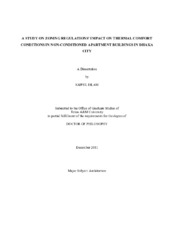| dc.description.abstract | Unfavorable thermal comfort conditions are common in the non-conditioned apartment buildings typical of Dhaka (Ali, 2007; Hafiz, 2004). Causes behind such unfavorable thermal comfort conditions include (but are not limited to) Dhaka?s climate, microclimate in Dhaka's typical residential neighborhood, its socio-economic context, housing type, and its inadequate planning regulations. Dhaka's climate is hot humid but it can be tackled with well designed buildings as well as well as designed neighborhoods, both of which demands ample open space. However, due to land scarcity and high population density, building developments lack open spaces and that results in unfavorable thermal comfort conditions in apartment buildings. Dhaka?s previous zoning regulations were unable to control this dense development, and therefore, a new set of zoning regulations were enacted (2008). However, no post-evaluation study was conducted to research the effect of this new set of regulations.
The intention of this research is to first evaluate the existing regulations, and second, to suggest appropriate zoning regulation schemes for Dhaka's non-conditioned apartment buildings (for a lot size of 1/3 acre), which would provide favorable thermal comfort conditions without changing its existing density. To accomplish the first goal, this research analyzed two existing zoning schemes (one based on regulations of 1996, and the other based on the regulations of 2008). To accomplish the second goal, this research analyzed two hypothetical zoning schemes. The hypothetical ones were studied because this research finds 1996 and 2008 regulations to be two extremes (in terms of allowing open space and building height), and therefore examination of in-between alternative zoning schemes seemed essential for this study.
To analyze the four zoning regulation schemes' impact on thermal comfort in apartment buildings, four sets of built environment were created in EnergyPlus (Energy Simulation software) as well as in Fluent (Computational Fluid Dynamics software). Each set of built environment is a cluster of nine buildings; and each set is different from each other in terms of their building footprints and building heights.
The building on the center was modeled implicitly, and remaining buildings were modeled as solid blocks (to act as neighboring buildings) for blocking sun and wind. The ES and CFD software simulated possible solar, daylight, and wind availability inside the central building, and consequently produce data on thermal comfort conditions, namely indoor temperature and air velocity. The simulation results were compared to see which zoning schemes provided the most favorable thermal comfort conditions. This research found one of the in-between schemes (60% allowable footprint, 9-story height limit) to be more appropriate in terms of thermal comfort conditions than the other three schemes; because it provides better solar protection and better natural ventilation and consequently it reduces indoor temperature and increases indoor air velocity. | en |


